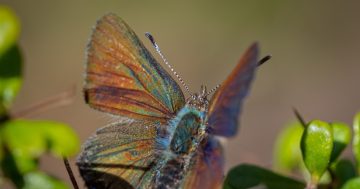
The Batemans Bay monarch butterflies have little identification tags stuck to their wings. Photo: Rowena Magee.
If you spot a butterfly in your garden with a shiny disc on its wing, don’t worry, it’s not an alien invasion or a spy camera, the bejewelled specimen is the subject of a Eurobodalla-based monarch butterfly-tracking program.
Batemans Bay’s own Madame Butterfly Rowena Magee is asking people to keep an eye out for butterflies with identification stickers on their wings and, if they find one deceased, log details on the monarch migration website.
“The live butterflies should never be caught,” she stressed.
Rowena has bred and released hundreds of monarchs over summer and she’s hoping they will survive winter in the Eurobodalla area before mating in spring when the weather warms up.
“Then they will die. These are the butterflies I’m hoping will be found,” she explained.
The tags have the New Zealand website on them, along with a unique identification number. Before releasing the butterflies, Rowena records the date, gender and tag number and, if the details are logged on the website by a member of the public, she will be notified of the location.
“I have been alerting the Eurobodalla public through social media to keep eyes to the sky and inform me of any sightings,” she said.
“I want to see if my monarchs return in spring after overwintering and hopefully learn of a local overwintering site in the Eurobodalla.”
She said people who found a deceased butterfly with a tag should provide a photo, the location and date, and state the condition of the butterfly, for example, if it has broken or faded wings.
Despite a drop in numbers following the Black Summer bushfires, other species of butterflies have flourished over summer, with rain and fresh growth providing ideal conditions for them.
However, Rowena said a loss of habitat during the fires, along with disease and predators such as praying mantis, spiders, tachinid flies, ants and lizards, had contributed to a drop in monarch numbers, so she was doing what she could to ensure their survival.
“It was thought the next generation of children may never see a monarch,” she said.
“I raise my monarchs inside from the eggs I harvest twice daily off my plants.
“As they progress through to larger caterpillars, I put them into my predator-safe enclosure outside, so when they pupate and eclose (emerge from their chrysalis) they can dry their wings safely and fly free after about four to five hours.”

Rowena Magee releasing her monarch butterflies in her garden at Batemans Bay. Photo: Rowena Magee.
Rowena’s love of monarchs began as a young child in New Zealand, where every garden had a swan plant (milkweed) in it, often by the front door.
“I grew up watching this magical metamorphosis from egg to caterpillar to butterfly, just as my children did later on,” she said.
“With moving to Australia, I kept looking for monarchs and 10 years later I saw my first Australian monarch in Castlemaine, Victoria. I was so excited and knew what my mission would be – to establish a monarch habitat and have them in our area at Batemans Bay.”
In November 2019, she planted milkweed collected from Victoria, and collected monarch caterpillars and eggs from Eden and, even after losing some due to the heat of the winds and Black Summer fires, Rowena still managed to release 279 that year.
In April 2021, she began tagging her monarchs as part of a new Zealand-based citizen science project, before releasing them.
Rowena has been invited to speak about her butterflies at schools, garden clubs and private events over the past four years.
“I love educating people on the plight of this butterfly and have been doing PowerPoint presentations along with a show-and-tell of the butterfly through its entire metamorphosis, by having a pop-up enclosure on hand for those present to see from egg to butterfly,” she said.
Her next mission is to try to locate local overwintering sites.
Monarchs eat only milkweed and, while Rowena hopes people will plant it in their gardens to encourage the butterflies, she recommends people place a bag over the seedpods before they burst open to stop the uncontrolled spread of the plant.
“I have had people contact me saying they haven’t seen monarchs for years but they’re seeing them locally now,” Rowena said.
The wanderer or monarch butterfly (Danaus Plexippus) was blown to Australia by the wind in the early 1800s. As it wasn’t introduced, it is considered naturalised due to it “finding its own way” here.
The lesser wanderer (Danaus petilia) is indigenous to Australia and found widely in South Australia and Queensland where milkweed, also its host plant, is readily available through plant nurseries and small, specialised butterfly shops.
Eurobodalla residents can find out more about the tracking project and log tags on the monarch research website.







